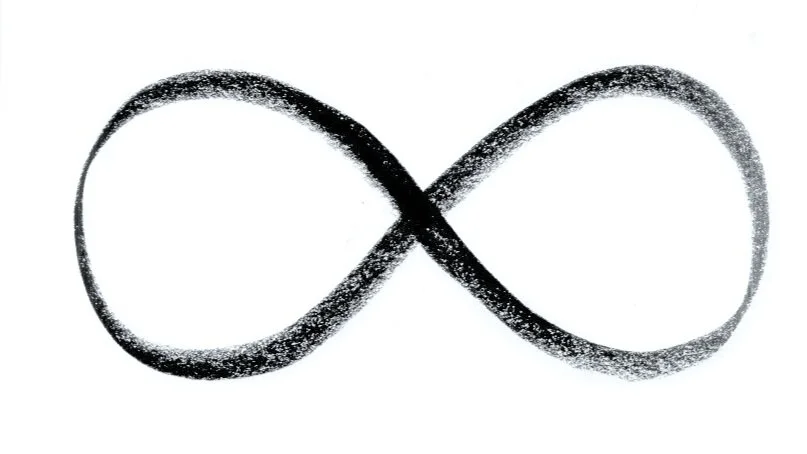The Primary Shapes in Guided Drawing: The Lemniscate
The Lemniscate in action
The structure of Guided Drawing is based on a number of primary shapes, which all have a universal, archetypal quality. A structured starting-point for fearful clients can be to practice one or two of the primary shapes, as instructed by the therapist. These movements can be taken into repetition, until clients feel confident enough to start on their own. Gradually many shapes come into play to tell their story. Another less directive beginning is to just flow with whatever the hands want to do in accordance with the client’s body-perception. In this case one will get a mixture of shapes that will want to be sorted and understood. In both cases clients experience a number of different movements which appear on the paper as shapes. The therapist, in addition, has the option of introducing certain shapes as a non-verbal intervention. Such interventions, drawn in repetition, will provoke a different felt sense, an option of change away from the helpless, overwhelmed, down-trodden, angry, terrified or dissociated state the client knows so well. This new felt sense may lead to reviewing old belief systems or simply practicing a different option to life.
THE LEMNISCATE
Lemniscate is the term for a horizontal figure eight. Of all the primary shapes this is the least threatening. It is without exception experienced as positive rhythmic flow without any threat of overwhelm.
Physiology: The rhythmic flow from one circle into the next, as well as the crossing over from one side to the other is deeply harmonizing. The rising and falling motion is simultaneously settling and uplifting. The motor impulse can connect the left and right side of the body, as well as the left and right brain hemispheres and bring them in sync.
In Buddhism the lemniscate is related to the practise of meditation. In his ‘Raja-Yoga’, Swami Vivekananda describes,
“...the structure of the spinal column in the following way: If we take the figure-eight horizontally, there are two parts, which are connected in the middle. Suppose you add eight after eight, piled one on top of the other, that will represent the spinal cord. The left is the ida, the right pingala, and that hollow channel which runs through the center of the spinal cord is the susumna.”
Lama Govinda continues:
“The susumna is closed at its lower end, as long as the latent creative forces of the Kundalini (or ‘libido’, as modern psychologists would say) are not awakened. In this state the Kundalini, which is likened to a coiled serpent (the symbol of latent energy) blocks the entrance to the susumna. By awakening the Kundalini’s dormant forces, which otherwise are absorbed in subconscious and purely bodily functions, and by directing them to the higher center, the energies thus released are transformed and sublimated until their perfect unfoldment and conscious realisation is achieved in the highest center. This is the aim and purpose of the Kundalini Yoga, of pranayama, and of all other exercises through which the chakras are activated and made into centers of conscious realization.” (Govinda 1959)
Physiology of the Lemniscate
Lemniscate Ouroboros
Archetype: Throughout medieval Europe, the lemniscate or figure eight was known for representing ‘white magic’, as opposed to the circle, which symbolised ‘black magic’. White magic, associated with all healing arts, respects another person or entity. It does not manipulate the other or impose its will. Communication flows between two circles. In black magic, the individual has to conform and stay within the one circle, the matriarchal ouroboros, and is exposed there to the pressure of group demands, and the fascinating splendour and terror of the unconscious. At the core black magic works with fear. The lemniscate or figure eight is based on a relationship of equals, the flow is fueled by love and characterised by respect for the other than me.
Medical professionals and chemists use the figure eight winding its way around the Greek wand of Aesculapius with its intertwined snakes as a symbol of healing.
Rod of Asclepius
Intervention: Accordingly, the shape of the LEMNISCATE is one of the most important intervention tools in Guided Drawing. It can assist dissociated, frozen clients to gently find a rhythm they are comfortable with. The rising and settling motion teaches their nervous system that it can do the same. The rhythmic repetition heals fragmentation, melts freeze states, and brings gentle motion into blockages.
Excerpted From: Healing Trauma with Guided Drawing; Cornelia Elbrecht 2018
Healing Trauma with Guided Drawing ONLINE!
If you are interested in incorporating Guided Drawing into your practice or as part of your professional development, take a look at our next available online course starting
02 February 2020
AThR, SEP, ANZACATA, IEATA
Now Available in a Chinese Language translation
Featured Blogs on Guided Drawing
The Lemniscate in it’s essence










